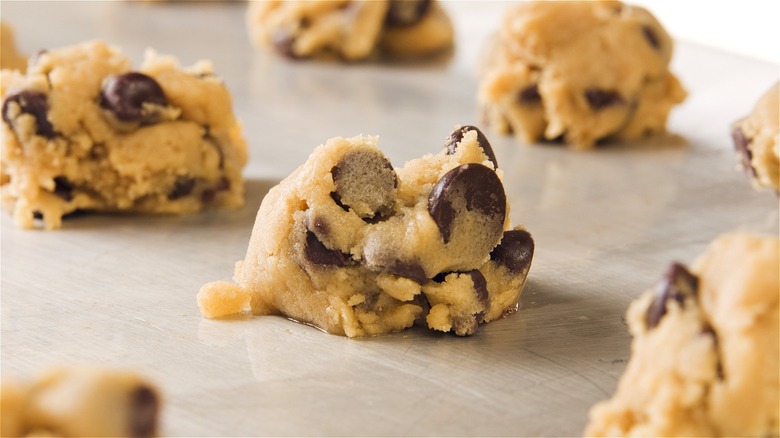For Perfect Cookie Dough, Make Sure Your Butter Isn't Too Soft
Every delectable cookie recipe begins with a perfectly mixed, sweetened dough good enough to eat. Whether you favor chocolate chip cookies or the peanut butter variety, most good cookie recipes begin with the creaming of sugar with room-temperature butter. Standout cookie dough has a distinct airiness thanks to whipped fat, sugar, and eggs. If you often allow butter to soften for an immeasurable amount of time, or find yourself with cold butter and melt this golden fat in the microwave to speed up the softening process, you may be indirectly compromising the resulting consistency of your cookies. Instead of light and chewy baked treats, your freshly baked cookies will be denser and more spread out with crisped edges.
Cookie dough that hasn't been properly aerated becomes heavy, impacting the resulting texture of your baked goods. Use room-temperature butter to make a smooth whipped cookie dough base. While general room temperature ranges between 68 and 72 degrees Fahrenheit, room temperature butter is considered ready for use when sitting as low as 65 degrees Fahrenheit – which is cooler than most people assume. Baking-ready butter should have a little give without losing the entirety of its structure when touched. This just-right room-temperature butter is necessary for transforming light and fluffy cookie dough into delicious homemade cookies. So, how do you ensure your butter is at the proper temperature for cookie making?
Telltale signs of just-right room-temperature butter
Now that you know cooled room-temperature butter is necessary for achieving soft and light cookie dough, learning the characteristics associated with the right temperature is essential. Ideal baking-butter tends to run on the cooler side, and shouldn't have a greasy sheen. You should be able to press the butter without easily sticking your entire finger through the softened portion.
To effectively soften butter, set out your designated portion roughly 30 minutes before mixing the required ingredients. If you're pressed for time and want to soften butter faster, use a box grater or cut your intended block into small chunks. Smaller pieces will reach room temperature faster, decreasing the softening time by at least 15 minutes. Ensure this primary ingredient is ready to be whipped by checking the consistency frequently. For extra precision, you can also use a food thermometer and whip the butter into your sugar when its internal temperature is between 63 and 68 degrees Fahrenheit.
Cookie recipes rely on the aeration of whipped fat. Room-temperature butter becomes exceedingly light when whipped, trapping air between fat molecules to create evenly textured baked goods. Discovering the importance of using room-temperature butter is key when learning how to make the perfect cookie dough. However, tepid butter alone doesn't guarantee soft and chewy cookies.
How to create ideal cookie dough every single time
Butter aside, there is a surefire list of cookie dough mistakes that everyone makes. Even though starting your cookie dough with room-temperature butter is crucial, using room-temperature eggs is also beneficial. Eggs serve as an emulsifier yet their stabilizing effect may be affected if added to cookie dough straight from the refrigerator. Room-temperature eggs blend more easily with whipped sugar and butter, giving your resulting cookies extra rise and tenderness. Room-temperature eggs also incorporate additional air into your cookie dough, helping to elevate its texture to peak fluffiness.
Beyond the importance of using room-temperature ingredients, measuring your dry ingredients with precision is crucial. Use a kitchen scale instead of measuring cups for the most accurate results. And to maintain your cookie dough's light and airy consistency, avoid overmixing at all costs. When combining wet and dry ingredients, be mindful not to over-stir as doing so may over-develop the gluten in your added flour resulting in tough cookies. Overmixing cookie dough may also warm your softened butter, which would give you greasy, heavy dough and dense baked goods. While every step in the cookie-making process matters, the first step in creating light and fluffy cookie dough is using cooled, just malleable butter.


